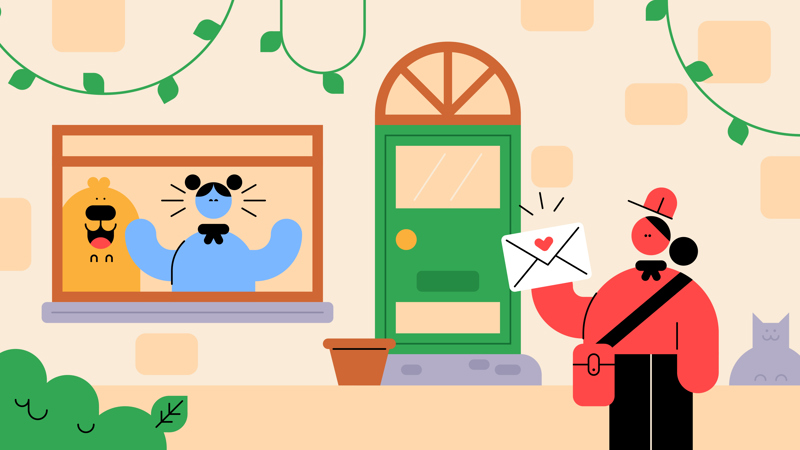
Postman pals
You’ll need
- A4 paper
- Pens or pencils
- Envelopes
- Stamps
- Flat items to add to the letter (for example: stickers, bookmarks, bookplates or photos)
Before you begin
- Ask parents and carers for permission for everyone to use their home addresses in this activity. Ask them to give their young person a Post-it note (or piece of paper) with their address written on it.
- Anyone who doesn’t want to (or can’t) use their home address should address their letter to the meeting place. You may want to prepare some Post-it notes (or pieces of paper) with the meeting place address on it.
Create the contents
- The person leading the activity should give everyone a piece of paper and some craft materials.
- Everyone should make something brilliant and colourful to share with a friend. People shouldn’t pick one person to send their message to – the creations will all get mixed up, so no one knows who their message will go to.
It’s up to each person what they do. They may want to draw something like an animal, something from nature, or even a spaceship. They could include a note, a joke, a poem, or just a message wishing someone a good day.
- Everyone should gather any extra surprises they’ll add, for example, photos, stickers, or bookmarks.
- The person leading the activity should collect all of the letters and drawings. They should check through them to make sure there’s nothing inappropriate before sending. They should then mix them up.
Perhaps some adults could check the letters while someone else explains the addresses.
Address the envelopes
- The person leading the activity should explain that addresses are written line by line. First is the name of the person you want to read the letter, then the number or name of the house (or building). Then the street name, the village or town name, and the postcode. All of this information helps the piece of post get to the right person. People might want to imagine zooming out from the person to their house, their street, and their town.
- Everyone should copy their name and address (or their name and the meeting place address) onto an envelope.
- Everyone should have a go at trying to learn their address. They could put it into a story, read it over and over again, or sing it to a tune.
- The person leading the activity should ask if anyone knows what else the envelope needs to reach its destination. It needs a stamp. The person leading the activity should explain that stamps come in two classes, and they usually have the monarch's head on. Sometimes they have other pictures instead.
The first stamp to have the head of someone who wasn’t a king or queen had the head of Baden-Powell, who founded Scouts.
- Everyone should stick a stamp on the top right-hand corner of the envelope. The person leading the activity should explain that stamps always go here. They could show people the postmark stamps often receive so they can’t be used again.
- The person leading the activity should collect the envelopes, and make sure that all the addresses are legible.
- The person leading the activity should mix the letters and envelopes up, so everyone’s artwork will be sent to another person.
- Everyone should seal their envelope (without peeking inside!).
- Everyone should post the letters off and wait for the surprise post to arrive.
Reflection
This activity was a fun way for everyone to remember their address and how to post a letter. Why is it important for people to know their address? People could think about how it could be important if there were an emergency and they needed to call 999, or if they got lost and needed to talk to the police. Remind everyone that people should only give out their home address if it’s absolutely necessary and they should check with a parent or carer first.
Has anyone ever received a letter or card through the post? How did they feel when they saw an envelope with their name on? It can be really exciting to get something in the post (unless you’re a grown up and it’s a bill!). Would anyone like to write a letter or card to someone else in their family or a friend? How do you think they’d feel when they received it?
Safety
All activities must be safely managed. You must complete a thorough risk assessment and take appropriate steps to reduce risk. Use the safety checklist to help you plan and risk assess your activity. Always get approval for the activity, and have suitable supervision and an InTouch process.
People’s notes could include instructions for a game or activity to play in another session.
It’s OK if people can’t write out their own address. People can help them with their envelopes. It doesn’t matter if people’s letters are written or drawn – it’s up to each person.
All Scout activities should be inclusive and accessible.
You could make a card for someone in your family and write the address on the envelope then post or give it to them. You could also link addresses to map reading, and use addresses to find things or places on a map.

